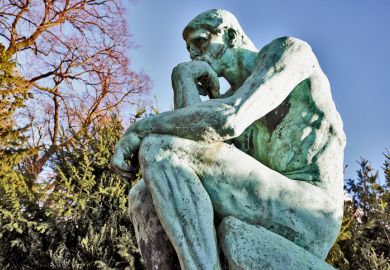The autumn 1997 issue of Daedalus consists of 15 articles about the academic profession in the United States. All the essays are of an exceptionally high standard, each containing interesting information and stimulating analysis and opinions. The volume deserves to be read in Britain, not least because its authors discuss matters that are just beginning to loom large in academic life here. Despite the tremendous pressures felt by universities these days, and the articles are not short on grim facts, the volume also has about it an air of optimism that is both realistic and cheering.
Part of the difficulty about thinking sensibly about higher education is that it includes so many different things. The academic profession, as one contributor puts it, is a multitude of tribes and territories hosting subcultures that speak in strange tongues. Viewed internationally, the American university system is "inordinately large, radically decentralised, extremely diversified, uniquely competitive and uncommonly entrepreneurial". It embraces more than 3,600 institutions which range from a hundred or so major research and teaching universities to about 1,400 colleges, including short-term vocational courses and adult education.
The system as a whole employs more than half a million men and women, seven-tenths of whom have earned doctoral degrees, half of whom are aged between 40 and 54, and 60 per cent of whom are tenured. For more than a century, higher education has been expanding; but now it has reached a plateau. There is little enthusiasm for expansion since nearly two-thirds of all high-school graduates go on to some form of higher education.
It has been a tremendous success story, but the past 20 years have changed fundamentally the relationship between universities and colleges and the wider community. Instead of being autonomous in deciding what to do and how to do it, universities have now to take more account of demands from outside.
Arthur Levine sets out the issues succinctly in the opening paper: first, there are changing attitudes and demands made of academics by their patrons. Government is the most important source of funding by far for nearly all American universities. Now that higher education is not a growth industry, government money is tight and activity regulated. Institutions have to work within budget, be efficient and deliver services effectively. Unit costs are driven down, student numbers controlled, new technologies introduced, security of employment undermined. Issues that before were decided almost entirely by the profession - what to teach and how, research areas and how to balance teaching and research - are now more often determined by others.
Second, students have changed. As higher education has opened out, the young man going naturally from high school to college has become unrepresentative of the student body. By 1993, 38 per cent of students in the US were over 25; 61 per cent had a regular job; 56 per cent were women; and 42 per cent were part-time. Mature students require clear contractual agreements with institutions, seek specific services, want guarantees that these will be provided in an affordable and efficient manner and that they will be looked after by well-trained staff.
Changes in patronage and in student demand, combined with new technologies and with private business initiatives, further transform the traditional university or college. Why support costly campuses and dons when the very best teaching materials can be provided in your own home or in nearby classrooms through electronic media? Why have complicated syllabuses when a professional package can be marketed so easily? Disney, IBM, Bell Atlantic and Microsoft are just waiting for higher education to explode into profitability.
The very diverse academic profession has found it difficult to keep up. Dons have never been good at running the closed shop. A majority of the profession is still tenured, though with the abolition of the retirement age, it is an ageing profession. A decision of the California state government can still take out 2,000 jobs over three years; permanent appointments are replaced by part-timers or by adjunct professors; and universities replace jobs by contracting out certain activities.
Although there remains a strong commitment to teaching and the inculcation of civilising values, entry into the university professions is increasingly by publication of research. This is extremely costly and may not by itself be a good indicator of suitability for appointment. (Less than a tenth of any published research is of lasting value, as one essay points out.) To get a PhD in America now takes more than 12 years, the average age at qualification being 35 years and four months. Even so, with 41,610 doctoral students graduating in 1995 the prospects for academic employment are bleak. In chemistry 250, or 12 per cent of all those getting a doctorate did not find a suitable job to match their skills. In the humanities, as R. M. Douglas notes in a brilliant and dispassionate essay, a book contract is the minimum opening bid for any tenure-track position. There are, on average, 105 applicants for every opening in history, and the figures are higher for English and philosophy. Moreover, a very high proportion of these are well-qualified candidates. Good liberal arts colleges, and even inner-city vocational community colleges, can now look to appointing from shortlists where all the candidates have a book published and a second under contract.
About half way through the volume the subject matter changes. Moving away from higher education structures, the woes of the academic profession, and public policy, the discussion takes a more speculative direction: Eugene Goodheart offers some "Reflections on the culture wars" and John Henry Newman makes his first appearance in the book. Charles Bernstein offers us a text from Dorothy Parker and Marlene Dietrich singing in a gorilla costume. Jay Labinger tells us of some interesting debates relating to scientific knowledge. For some, these essays remind them of ways in which higher education is not just about delivering a service, nor of pressing people into grey uniformity, but of stimulating while disciplining the mind. Universities are the guardians of objectivity, disinterestedness, tradition, aesthetic appreciation and the unending search for new knowledge and better understanding. True, some academic controversies may not do much more for humanity than those medieval wrangles about the number of angels that could be accommodated on the point of a pin. But there is a sense in which there is a real bottom line: civilised societies need educated citizens and educated citizens come from the values fostered by academics in real universities; and in America, despite everything, such people and such institutions still thrive.
Right at the end of the volume, Philip Altbach makes some international comparisons. No other country has experienced quite the trauma of higher education in North America. But Britain comes near, having been subject to far-reaching government-led reforms. Altbach highlights "the abolition of tenure, the amalgamation of the polytechnics with the universities that more than doubled the size of the university system, and the imposition of performance measures for teaching and research and the allocation of funds to universities based on these measures". These policies have significantly affected the professoriate and, according to Carnegie Foundation research, lowered the morale of British dons.
But perhaps we pass through the refiner's fire. When Henry VIII established a new college in Cambridge in the name of the Trinity, he dedicated it to the holy and undivided Trinity, because, so the story goes, he wanted to keep his options open. Similarly, Baroness Blackstone, in her meditated attack on the colleges of Oxford and Cambridge and in her determination to put Britain's universities under central political and administrative control, has no wish to harm the excellence of these institutions: she just wishes to keep her options open. Cambridge delivered to the Tudors the educational and scholarly goods their age required while at the same time making the place of knowledge more robust. These essays in Daedalus suggest that the universities and colleges of North America are poised to do likewise. There must be a lesson in that for both government ministers and dons in Britain's post-Dearing age.
Gordon Johnson is president, Wolfson College, Cambridge.
Daedalus: Journal of the American Academy of Arts and Sciences, Volume 126, No. 4; The American Academic Profession
Editor - Stephen R. Graubard
ISBN - ISSN 0011 5266
Publisher - American Academy of Arts and Sciences
Price - $56.50 (institutions); $40.00 (individuals)
Register to continue
Why register?
- Registration is free and only takes a moment
- Once registered, you can read 3 articles a month
- Sign up for our newsletter
Subscribe
Or subscribe for unlimited access to:
- Unlimited access to news, views, insights & reviews
- Digital editions
- Digital access to THE’s university and college rankings analysis
Already registered or a current subscriber? Login



